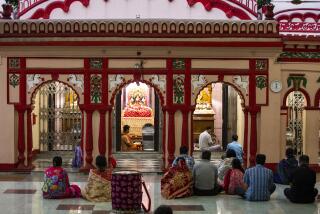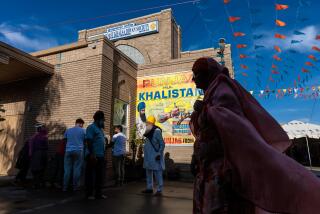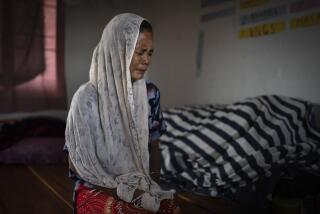In India, Even Remotest Area Stands Divided
- Share via
LEH, India — This cold and barren land of rocky slopes and glaciers, of cliff-side Buddhist monasteries and of the wild yak, is the most remote and unpopulated corner of India.
Until a road was cut through in 1964, an overland journey from the cities on the Vale of Kashmir took weeks. A sloping airstrip was built in 1974. But even now, in winter, this city and the surrounding district of Ladakh, twice the size of Switzerland, are cut off from the outside world for months at a time.
The Ladakh region is so isolated, its terrain so intimidating, that national elections held in the rest of India in December had to be delayed here until the end of April. Poll workers had to leave five days in advance by helicopter and horse to reach some of the voting places, several of which are more than 15,000 feet above sea level.
Suffers Same Divisions
Even here on the very edge of civilization, where the pressures of overpopulation cannot be blamed, Ladakh suffers from the religious, linguistic, tribal and caste divisions that have plagued the rest of India since it became independent from Britain in 1947.
That such a remote place, sandwiched between the great Karakoram and Himalayan mountain ranges, could share in the internal divisions of steamy Bombay and cosmopolitan New Delhi demonstrates the extent of India’s problem.
“Strangely enough,” Hindustan Times reporter S.S. Banyal wrote in a dispatch from Leh, “even at the remotest corner of India, the communal passions are as strong as elsewhere.”
The election of April 24, for example, in which the 150,000 residents of Ladakh chose their representative in the Indian Lok Sabha, the lower house of Parliament, was contested almost exclusively along religious lines.
Founded by Lion of Kashmir’
Muslims, who account for about half the population, were staunchly behind the Muslim candidate put up by the National Conference Party, which was founded by the late Sheik Mohammad Abdullah, the “Lion of Kashmir.”
Buddhists, who make up the other half, were solidly behind the Buddhist candidate put up by the ruling Congress-I Party of Prime Minister Rajiv Gandhi.
“There has developed a hatred between the two communities,” said Dr. Farooq Abdullah, son of the Lion of Kashmir and leader of the National Conference Party since his father died in 1982. “Ask any ordinary man and he will tell you the hatred is growing.”
Some here blame the relatively new split between Ladakhi Muslims and Buddhists on Farooq Abdullah and his party. “The National Conference is involved,” said the head Buddhist priest, or lama, of Ladakh, the venerable Kushok Bakula. “They tried to communalize the issues. Farooq Abdullah came here and did not visit any Buddhists.”
Communal Disharmony Denied
Others deny the existence of any religious or communal divisions. “If this is communal disharmony,” Mohammad Akbar Ladakhi said at a polling place in Leh, “then there can be no such thing as harmony.”
Ladakhi, a Muslim and a retired civil servant from the nearby village of Chochotan, elbowed aside a political leader who was attempting to tell reporters a story about violence at another polling station. He gestured toward lines of Buddhists and Muslims peacefully waiting their turn to vote, and added:
“This is a place of traditional communal harmony. Take me. My wife is Christian, my maternal relatives are Buddhist, and my father’s side is very, very orthodox Shia (Muslim).”
But despite the denials of religious divisions, the only question that remained after the voting here in the cloudless heights where China, the Soviet Union, Pakistan, and Afghanistan meet, was whether Ladakh would be won by the Buddhist candidate or the Muslim. (The victor ultimately was the Buddhist, P. Namgyal).
Special Status Sought
Of course, there was more at stake. For years, the mostly Buddhist population centered in Leh has been pushing the central government of India to classify the people of Ladakh as a “scheduled tribe” or backward class, which would give them special minority preferences in government jobs and university admissions.
“There are so many facilities that would be open to us if we got scheduled tribe status,” said an enthusiastic Lama Lobzang. “Students will get stipends, special admissions. . . . “
Ladakh is a district of the state of Jammu and Kashmir. If scheduled tribe status were given to the Ladakhi, both Buddhist and Muslim, it would give them an advantage over the 6 million Kashmiri people who live in the valleys in terms of admission to Kashmir universities and government jobs. Therefore, the majority of the Kashmiri Muslims and the National Conference Party oppose special status for the Ladakhis, 90% of whom are illiterate.
On a small scale, this is a replay of the furor that has engulfed the western Indian state of Gujarat, where more than 80 people have been killed this year in caste warfare over the special preferences given the members of lower castes and untouchables in government-funded universities and government jobs. Before it hit Gujarat, the same dispute flared violently in the central Indian state of Madhya Pradesh.
Saffron-Robed Lamas
In tiny, traditionally peaceful Ladakh, a place of saffron-robed lamas and devout Buddhists who walk the dun-colored hills swinging copper prayer bells and chanting mantras, a demonstration calling for scheduled tribe status for Ladakhis last summer resulted in two deaths, including that of a prominent Buddhist monk, when police fired on a crowd of demonstrators.
Even before independence, historians and political scientists began predicting the eventual unraveling of India because of such pressures--the pressures of social caste and religion. No country made up of so many different religions, languages and social levels, they argued, could possibly remain intact.
The partition of British India into East and West Pakistan and India was only the first in a chain reaction of splits the skeptics foresaw. Just as Eastern Europe had been Balkanized along linguistic lines following the collapse of the Austro-Hungarian Empire, so would India when the British left, they predicted.
“India stands the risk of being split up into a number of totalitarian small nationalities,” Indian Sanskrit scholar Suniti Kumar Chatterjee wrote in a 1957 book.
Torn by ‘Centrifugal’ Forces
Three years later, American scholar and journalist Selig S. Harrison, in his controversial book about India, “The Most Dangerous Decades,” wrote about the “centrifugal” forces--linguistic differences, religion, caste, communism--that threatened to tear India into a number of smaller states.
“India’s struggle for national survival is a struggle against herself,” Harrison, who is now with the Carnegie Endowment in Washington, went on to say.
But despite an almost continuous stream of prophesies about India shattering under its internal stresses, it has not, even after 38 years of independence.
The linguistic stresses seen by Harrison have to a great extent diminished, for the most part neutralized by the failure of the central government to use Hindi exclusively as the national language, by the continued reliance on English to conduct the nation’s business and by the use of regional languages in non-Hindi-speaking state governments.
Distinctive Languages
Two states, Tamil Nadu and Andhra Pradesh, with more than 100 million people between them, have state governments organized around distinctive languages.
Yet religious and caste conflicts continue. Many contend that India has never before been under the kind of strain it now endures, mainly because of the pressures from the nation’s 15 million Sikhs.
The Sikhs were among the most fervent of the Indian nationalists before independence. But there has always been a movement for a separate Sikh state.
Meanwhile, other signs of what Indians call “fissiparous” tendencies--defined in the dictionary as “biological fission”--abound in Indian society.
The caste conflict in Ahmedabad in Gujarat is the worst since 1969, when more than 800 people were killed. In Bombay, a militant Maharathi group, the Shiv Sena, described by one Indian English-language newspaper as a “fascist, parochial organization akin to Hitler’s notorious Brown Shirts,” swept recent city elections. In the northern state of Bihar, 14 tribal people were shot dead by police during a protest of police mistreatment of their people.
Hindu Backlash Feared
In the face of mounting Sikh militancy, intellectuals warn of a Hindu backlash. Indian Express columnist Swaminathan Aiyar wrote in an article headlined “The Hindu Factor”:
“The reservoir is beginning to fill up again. Terrorism has raised its head once more. Eleven people have fallen to (Sikh) terrorist bullets in 1985.”
Aiyara wrote that “a fearful Hindu community is a dangerous community,” and, practically promising Hindu violence against Sikhs if Sikh terrorism continues, warned that “fear can make a man go berserk.”
If it were not all so deadly serious--if lives were not being lost every day--it might appear that Indians almost revel in dwelling on divisive, fissiparous, contentious, forever-threatened India, the fragile giant.
The best-selling book of nonfiction here in the past few months is “India: The Siege Within--Challenges to a Nation’s Unity,” by Calcutta journalist M.J. Akbar.
Punjab Threat Cited
Akbar, a Kashmiri Muslim by heritage, contends that the most dangerous threat India faces today is the conflict with the Sikhs in Punjab. Like many writers before him, he allows himself a prediction:
“If (Indian) Punjab could manage to convert itself into the theocratic state of Khalistan, as West Punjab had become Pakistan in 1947, then the whole federal experiment of a united India would receive a blow from which it would probably never recover. If Punjab went, so would Kashmir.”
Such losses, according to the script, would lead to other losses. India is like an onion, the smallest Indian schoolchild delights in telling a visitor in explaining why a national government is needed: When you peel off all the outer skins, nothing remains.
And the great experiment of India--a nation formed from many nations, religions, languages and cultures, from the jungles of Kerala to the granite mountains of Ladakh in the most remote corner of the subcontinent--would be for naught.
Least changed of all might be Ladakh. The residents of the last place to be connected by road with Mother India still call themselves Ladakhis and refer to anyone from the outside as Indians.
“We don’t think we are part of India here,” said Sonam Tashi Typpa, a mountain guide in Leh. “We are different.”
More to Read
Sign up for Essential California
The most important California stories and recommendations in your inbox every morning.
You may occasionally receive promotional content from the Los Angeles Times.













